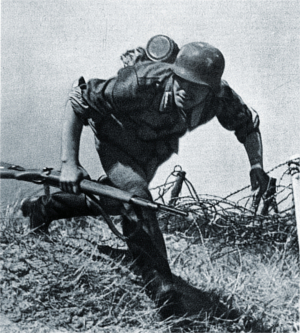In 1943 the German guidebook publisher Baedeker brought out a guide to [Axis]-occupied Poland. The book, which provides a comprehensive view of conditions in the area, is intended for the use of German residents and visitors. Its principal interest derives, however, not from what it describes, but from what it fails to describe.
It was researched and published at a time when the few surviving Jewish communities were concentrated in ghettoes. The mass extermination programme was under way, and must have been known to the Generalgouvernement officials who were among the sources for the guidebook, especially those who were concerned with the railway system.
There is no trace of these events, no reference to living Jews, and only the barest of references to a Jewish past, which is treated as an indeterminate period of time that has now come to an end.
[…]
Baedeker’s reference to Jews in the entry for Kazimierz nad Wisla, is the most direct in the guidebook: ‘German merchants left the town after it had been twice destroyed by the Swedes, in 1656 and 1657, and were replaced by Jews, with the permission of John III Sobieski in 1677 […] In 1939 the Jews were moved out.’
The verb used here is ‘aussiedeln’, which means ‘to move out without any indication of a destination’. The euphemism for deportation to the camps which was in use in 1942–3 was the related and slightly more positive word ‘umsiedeln’, which means ‘to resettle’.
This reference is the only one relating to near-contemporary Jews that actually uses a verb. Other similar references use the adjective ‘judenfrei’, free of Jews. In addition to Cracow, the term appears in Baedeker’s description of Lublin.
According to this version, the city had been in decline since the eighteenth century, after a fire in 1710 and the immigration of Jews who made Lublin their centre, and held annual synods until 1764. Jews had a Talmud school with the largest Talmudic library in Europe. In 1862 the city was 57 per cent Jewish; now it is ‘judenfrei’. The use of a verb to describe the process of making the city ‘judenfrei’ is avoided.
The text of Baedeker’s Lublin entry is unusual in that it actually describes elements of Jewish life, about which Hachette is silent. Elsewhere in Baedeker the language used of Jews in the historical sketches of several towns is almost formulaic. Both Tarnopol and Rzeszow are described as ‘formerly dominated by numerous Jews’.
Other towns (Sandomir, Przemysl, Czestochowa) were deserted by their German populations following the ravages of the Thirty Years’ War, and were re-populated by the immigration (‘Zuwanderung’) of numerous Jews, which led to the towns’ decline (‘Niedergang’). Almost every reference uses the word ‘numerous’ (‘zahlreich’).
The impression is clearly given that Jews arrived (from no specific place) after the early German residents left, and no earlier than the seventeenth century. Jews had, of course, been living in Poland in quite large numbers for hundreds of years previously, alongside German and Slav townspeople.¹³
The fate of Poland’s Jews is best illustrated by one small town whose synagogue is mentioned in Hachette. In Kamionka Strumilowa (Kamenka Bugskaya), on the far eastern edge of the Generalgouvernement, Hachette in 1939 describes a wooden synagogue from 1627, decorated with frescoes. Neither the building nor the Jewish population is mentioned in Baedeker, which refers only to a town of growing importance to the timber industry.
The Jews of the town had, in fact, been deported to their deaths in Bełżec in September and October 1942, while Oskar Steinheil was gathering his data. The only surviving Jewish presence in the area was a forced labour camp, liquidated a year later.
The disappearance of the Jews was not confined to the living: it also encompassed the dead. The Jewish cemetery in Lvov, clearly visible in Hachette’s city map, is a blank space in Baedeker (although curiously the two streets bordering it, with the Jewish names of Meiselsa and Rappoporta, are still shown). The main cemetery in Warsaw, which survived the war, is also a blank space in Baedeker, bordered by Catholic and Protestant cemeteries.
(Emphasis added.)
Concerning tourism itself in Poland under Fascism, this next description comes from Kristin Semmens’s Seeing Hitler’s Germany: Tourism in the Third Reich, page 171:
The process of touristification continued first in Poland. That Germans were travelling to the territory is noted in a gruesome observation by Victor Klemperer, who recorded in his diary that ‘vacationers back from Poland reported with disgust that “hundreds” were being shot each day’.⁷⁸
Yet such horrific events appeared to have little effect on tourist travel to some areas of Poland. Posen, the capital of the newly established Gau Wartheland, proved extremely popular as a destination for Germans from the Altreich.⁷⁹

